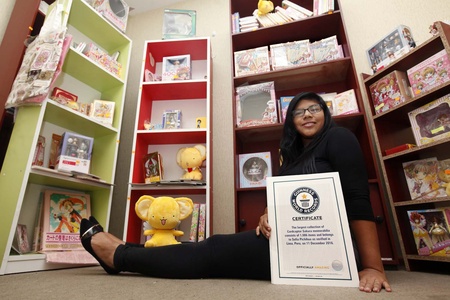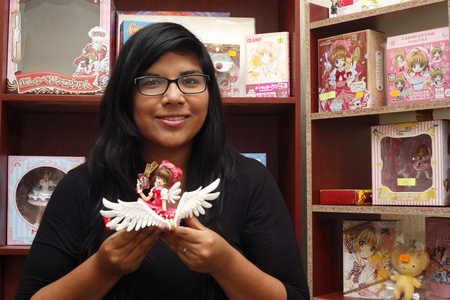Sofía Pichihua is not just any otaku. This manga fan, who began following the anime that aired on television back in 2000, has become the biggest collector of Cardcaptor Sakura , the manga by CLAMP, a female quartet of Japanese cartoonists who gave life to Sakura Kinomoto, a girl who discovers that she has magical powers after releasing a set of cards found in a book.
Sofia says that since she was a girl she watched anime through the open signal, but that it was with the character of Sakura that she felt like a true otaku. "It marked me, it was my first anime, I knew everything by heart, the characters, their tastes... everything you can imagine." He remembers that one of the first objects he collected was a series of Vinifan folders that were sold with the newspaper La República that his parents bought him.
Then he made a website and began to participate in forums such as Animekai, from Mexico. “I was the moderator of the forum about Sakura, I wanted to be the one who knew the most about this character.” When he entered the Pontifical Catholic University of Peru, he joined Anime H, a group that met during cultural Thursdays to watch movies and share their love for anime and manga.
OTAKU DIGITAL
In her office at the Andina agency, where she manages social networks, Sofía remembers that in 2005 she created a blog that was also called Anime H, and from which she reported on the manga conferences that were held in Lima and did interviews about anime production. and cinematography. It was what gave rise to Otaku Press, the blog that appeared in 2011 in the newspaper Perú 21, where he worked, and which now continues from its own domain.
In 2014, she traveled to Mexico to attend La Mole Comic Con, an international event where she did interviews and continued purchasing products for her personal Sakura collection. It was in that year that she decided that she wanted to apply for the Guinness Record, also motivated by another Peruvian otaku who was already in this famous record: Jorge Vásquez, who collected 1,792 pieces about The Knights of the Zodiac .
“He motivated me and I have told him so. So I started taking an inventory of everything I had, looking in my drawers and getting the basic pieces that I believed should not be missing from a collection.” Sofía had all the volumes of the manga (the printed comic strip) that had been translated into Spanish, except the first issue and the 11th edition. Luckily, she was able to get the first one (“It took me two years to get it,” she says with emotion), but eleven remains unfindable.
COLLECTOR'S OFFICE
It's not easy being a collector. The trade requires, in addition to a budget, order to classify all the products and know the market. Sofía Pichihua points out that she has bought products from Peru, Mexico, Spain, China and, of course, Japan. You have a contact to import these items, which range from figures, video games, DVDs and records, to wallets, posters, keychains, pens and towels.
“There are items that can cost between $200 and $500. There are even shoes, but not in my size,” says Sofía, whose most valuable product is a Gameboy dedicated to the character of which she also has VHS tapes. He says that he contacted other Sakura fans and that none of them wanted to sell the items they collected. “It is common to find collectors who want to achieve the Guinness Record.”
According to Sofía, there are 21 Guinness Records linked to manga and anime (including the one she obtained), which should not cause any surprise to those who have visited the Arenales Shopping Center, where items related to these comics are offered, or for those who have attended the festivals for otakus and cosplayers that take place in Lima. These are passionate and dedicated fans of this form of Japanese culture.
REACH THE RECORD
It is not easy to apply for the Guinness Record either. From the moment you apply to apply through a digital application, it can take three to six months to be accepted. Then, you need to register on its platform and send a record of the items following the rules of this international organization founded in 1951. One of its rules indicates that each of the items must be unique, that is, repeated products are not counted. .
Following the rules, Sofía had to look for two witnesses, one person with a reputation and another who is knowledgeable about the field in which she is applying. He chose a lawyer and Ana Takahashi, a Japanese teacher at the Peruvian Japanese Association. With them he had to record a video showing that he owned more than a thousand items in the series, with the difficulty of counting them one by one.
The final recording lasted about three hours in which Sofia showed she had 1,086 items. “I applied in 2016, the year that marked the 20th anniversary of the appearance of Sakura and the year in which the manga reappeared,” he explains. However, the organization's process meant that it was only this year that they informed him that he had met the requirements and had obtained the record. A few days later, it was announced on the official website and they sent him the certificate confirming it from London.
Before the interview ends, and after receiving congratulations from an office colleague who stops by to greet her, Sofia opens her Sakura wallet and shows me the same character's wallet and agenda. In previous days, the Spanish newspaper El País interviewed her before knowing her record for an article titled “Anime culture triumphs in Lima.” In that triumph, full of fans and events that continue to grow in the capital, Sofía already has her name written next to that of her favorite character.

* This article is published thanks to the agreement between the Peruvian Japanese Association (APJ) and the Discover Nikkei Project. Article originally published in Kaikan magazine No. 108, and adapted for Discover Nikkei.
© 2017 Texto y fotos: Asociación Peruano Japonesa











